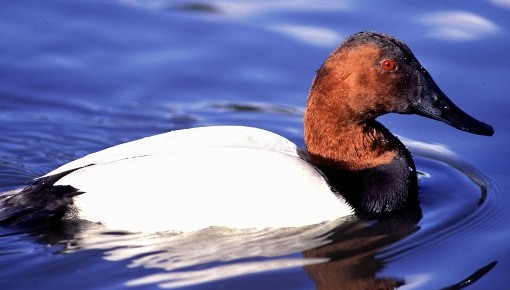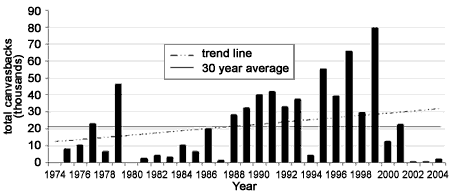Detroit River-Western Lake Erie Basin Indicator Project
Canvasback Population in Lake St. Clair/Detroit River/Western Lake Erie Basin
Background
More than three million waterfowl are estimated to migrate through the Great Lakes area annually. More than 300,000 diving ducks have been documented at one time during spring migration on the lower Detroit River (Manny et. al 1988). In 1991, retail sales related to waterfowl hunting in Michigan were estimated at $20.1 million and have most likely increased since.
Canvasbacks require large amounts of food to fuel their migration. They can dive as deep as 11 meters for aquatic plants, including wild celery, pondweeds, grasses, and sedges. These omnivores require foods provided by productive marshlands and, in particular, shallow water with dense beds of submergent and emergent vegetation. By mid-October, fall migration for canvasbacks is well underway. However, some flocks overwinter regularly on the lower Great Lakes and in particular in Lake St. Clair and along the St. Clair and Detroit Rivers. By mid-April, migrating canvasbacks will be moving north to their breeding grounds in central Canada (Cheskey and Wilson 2001).
Extensive beds of aquatic vegetation in the Detroit River ecosystem, particularly wild celery, once attracted large concentrations of divers, primarily canvasback. Rafts up to 12-14 km long have historically been described on Lake St. Clair (Pearce 1997). However, in the past 100 years discharges from industrial plants and municipal sewage effluent, along with the effects of large, deep draft vessels, have degraded the lower Detroit River ecosystem, thus resulting in the substantial decline of wild celery beds. Industrial and urban development, and agriculture reclamation projects, destroyed wetland breeding, migration stopover, and wintering areas. Periodic droughts have also severely reduced reproductive success of canvasbacks (Cheskey and Wilson 2001). Remnants of the once vast rafts of migratory waterfowl can still be found in the aquatic vegetative beds surrounding some of the islands in the Detroit River (U.S. Fish and Wildlife Service 2005).
Canvasbacks are of special interest across the continent because they are less common than most other ducks, making them a prize hit for duck hunters. They have been a game bird of choice among North American hunters with a well-deserved reputation as a fine table bird, and a handsome mount (Figure 1). During the years of market hunting, in the late 1800s and early 1900s, large numbers were shot stressing the viable population size. Even after the Migratory Bird Convention Act of 1917, which prohibited market hunting, the canvasbacks required special protection for many decades (Cheskey and Wilson 2001). Canvasbacks continued to decline between 1955 and 1974 (del Hoyo 1992a).

Figure 1. Canvasback (Aythya valisineria) (Photo Credit: USFWS)
Status and Trends
In 1974, several traditional canvasback migration staging areas were selected in Michigan and other Mississippi Flyway locations for inclusion in the coordinated canvasback survey. Air or ground surveys were scheduled to be conducted on or about November fifth each year. The important areas in Michigan included Lake St. Clair, the Detroit River, and Lake Erie. These three locations and 6 to 22 additional areas known to have canvasback use were inventoried annually between 1974 and 2004 (no survey in 1980). The data collected provide information that can be compared to breeding population estimates and January counts to help ascertain canvasback status.
The number of canvasbacks counted during the Michigan survey ranged from 125 in 1974 to a record high 79,300 in 1999 (Figure 2). The Michigan canvasback inventory along Lake St. Clair, the Detroit River, and Lake Erie exceeded the long-term average (22,000) 12 of the last 20 years. The 1974-2004 period of record can best be described as high year-to-year variability. Among the three important areas in Michigan, 93% of the canvasbacks were found on Lake St. Clair. The second most heavily used staging area in Michigan is the lower Detroit River/Lake Erie complex.

Figure 2. Total canvasbacks counted in the fall in Lake St. Clair, Detroit River and western Lake Erie basin (U.S.), 1974-2004 (data collected by Michigan Department of Natural Resources).
Large numbers of canvasbacks prefer the Canadian side of Lake St. Clair verses the U.S. side of Lake St. Clair for periods of time, then they move back to the U.S. side. For example, in 2002, Department of Natural Resources Biologists Ernest Kafcas and Joseph Robison witnessed a raft of canvasbacks nine miles long on the Canadian side of Lake St. Clair. The reason for this gradual shift in canvasback distribution in Lake St. Clair is most likely due to human disturbance and other factors, such as, a shift in vegetation beds. Also, Ontario has restrictions on how far off shore people are able to hunt, Michigan does not. Human disturbance plays a major role in the distribution of canvasbacks. From 2002-2004 Lake St. Clair, in Michigan and Ontario waters, had near record or record low counts of canvasbacks.
The trend of the Michigan canvasback inventory has roughly followed the trend of the total inventory of all survey areas in the Mississippi flyway since the late 1970s. However, the Lake St. Clair/Erie inventory for the U.S. and Canadian waters combined has been relatively stable compared to the trend of the total Mississippi Flyway inventory. Moreover, these locations appear to have staged a declining proportion of the total canvasbacks observed in the flyway since the early 1990s. From 1974 to 1993, the Lake St. Clair/Erie inventory accounted for 28-65% of the total canvasbacks observed and averaged 45%. That proportion declined to an average of 25% (range 18-38%) of the total canvasbacks observed across the flyway during 1994-1999 (Soulliere et al. 2000).
Survey effort has been fairly consistent across the flyway over time. However, this survey only provides an annual "snap shot" of canvasback fall staging activity. The smaller proportion of early November canvasback use on Lakes St. Clair and Erie maybe related to a delayed migration in the late 1990s compared to the 1970s and 1980s. In recent years, canvasbacks using upper Mississippi River pools normally migrate to the East Coast and likely pass over and/or stage on the lower Great Lakes after the early November survey (Bellrose 1980). A high number of canvasbacks observed in December and even wintering in southeast Michigan in recent mild-weather years supports this possibility (Soulliere et al. 2000). Southeast Michigan and connecting waters remain one of the most important regions for migrating canvasbacks in North America because of location between prairie breeding grounds and the primary wintering range of the East Coast, and because of its expansive open water and food resources.
Management Next Steps
The lower Detroit River is designated as an Important Bird Area that is globally significant as a site for congregating waterfowl. Continued emphasis should be placed on wetland conservation and management to sustain populations of these waterfowl. Populations have been managed through hunting restrictions and the North American Waterfowl Management Plan, which strives to conserve and develop prime habitat for these diving ducks throughout the continent (Cheskey and Wilson 2001).
Research/Monitoring Needs
The November canvasback survey should be continued to monitor populations of canvasbacks migrating through the Detroit River corridor and Mississippi Flyway. The surveys are important to determine nesting and wintering areas that are of significant importance to canvasbacks. Also, continuation of May Breeding Population Surveys is pertinent to determine reproduction success.
References
- Bellrose, F.C. 1980. Ducks, geese and swans of North America. Third edition. Stackpole, Harrisburg, Pennsylvania. pp. 540.
- Cheskey, E.D., and W.G. Wilson. 2001. Eastern Lake St. Clair Important Bird Area Conservation Plan. Can. Nature Fed., Bird Studies Canada, Fed. of Ontario Naturalists. pp. 9-10.
- del Hoyo, J. 1992. Canvasback. In Handbook of the Birds of the World. Vol. 1, No. 110. Lynx Edicions, Barcelona, Spain.
- Manny, B.A., T.A. Edsall, and E. Jaworski. 1988. The Detroit River, Michigan: An Ecological Profile. Biological Report 85 (7.17).
- Pearce, J. 1997. Cleansing Wetlands Disappeared As County Grew Up. Detroit News, October 6, 1997. http://detnews.com (July 2000). exit EPA
- Soulliere, G.J., T.E. Maples, and E.N. Kafcas. 2000. Twenty-five Years of Canvasback Inventory in Michigan, 1974-1999 . Michigan Department of Natural Resources, Wildlife Division Report No. 3332.
- U.S. Fish & Wildlife Service. Detroit River International Wildlife Refuge: Comprehensive Conservation Plan and Environmental Assessment. pp 25. (November 2005).
Contact Information regarding Canvasback Population in Lake St. Clair/Detroit River/Western Lake Erie Basin
Joseph D. Robison
Michigan DNR, Wildlife BiologistE-mail: robisnj@michigan.gov